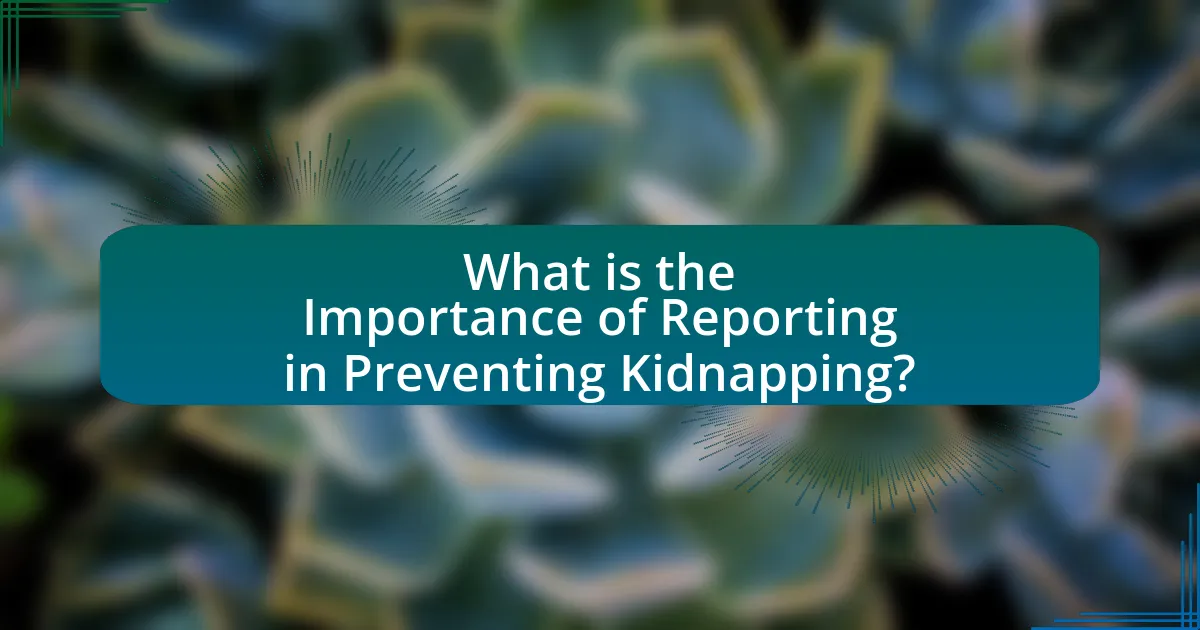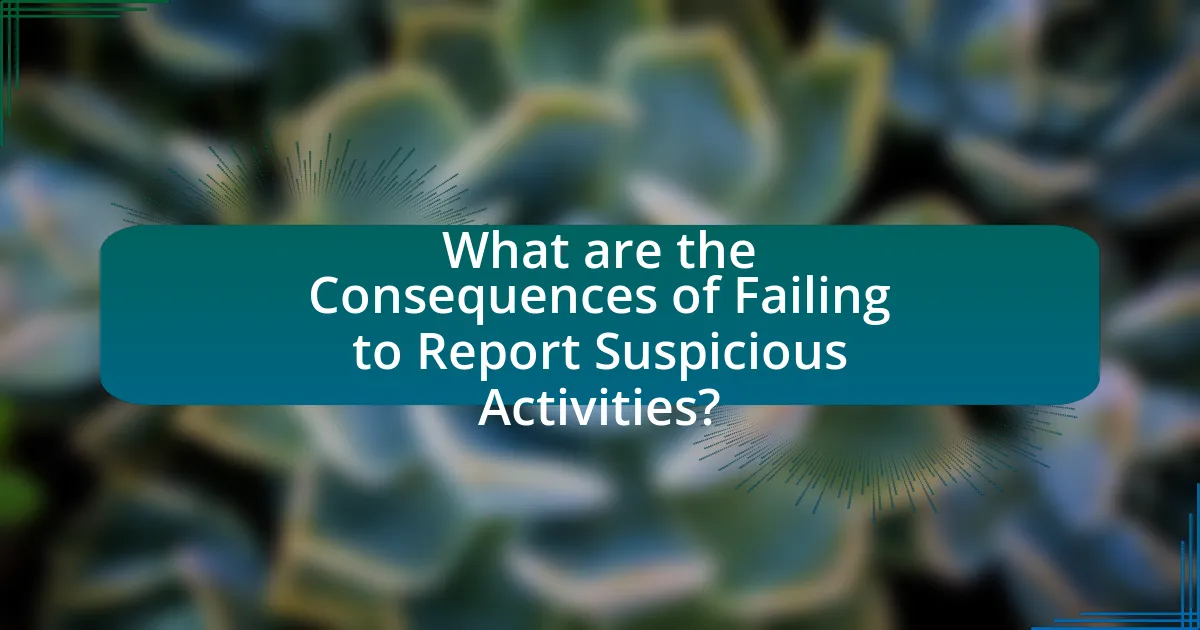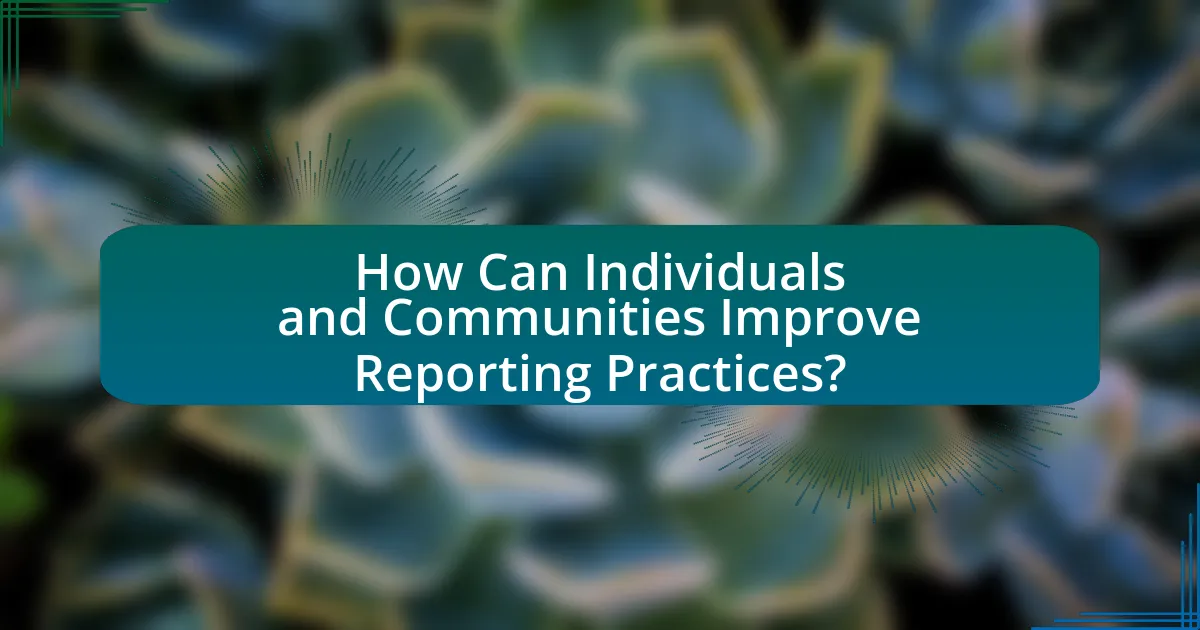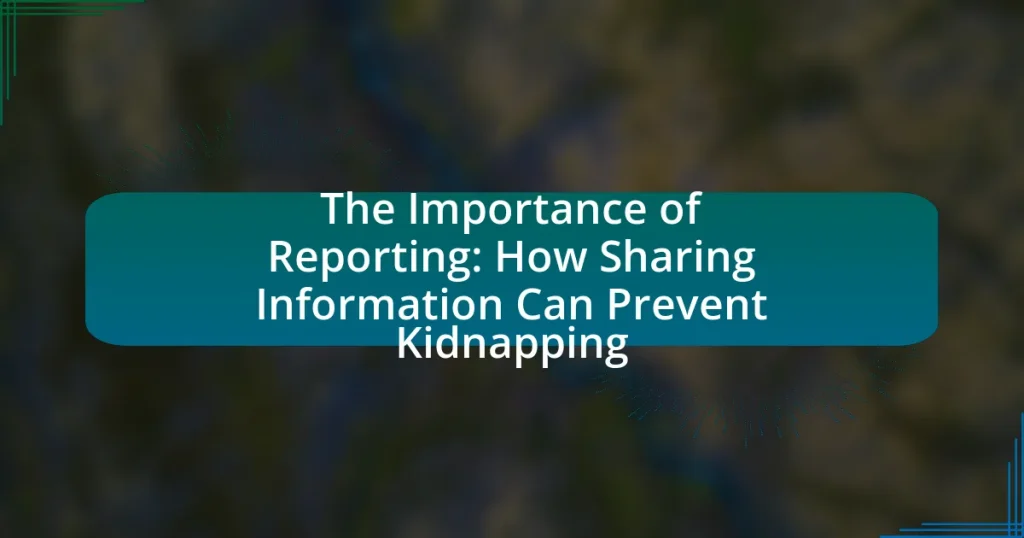The article focuses on the critical role of reporting in preventing kidnapping, emphasizing how timely intervention and resource allocation by law enforcement can mitigate risks. It discusses the importance of community involvement and information sharing, highlighting that active reporting systems lead to lower kidnapping rates. Key aspects include the types of information necessary for effective reporting, the consequences of failing to report suspicious activities, and the legal implications associated with non-compliance. Additionally, the article outlines strategies for improving reporting practices, the role of technology, and the significance of community awareness programs in fostering a culture of vigilance against potential kidnappings.

What is the Importance of Reporting in Preventing Kidnapping?
Reporting is crucial in preventing kidnapping as it facilitates timely intervention and resource allocation by law enforcement. When individuals report suspicious activities or potential threats, authorities can act quickly to investigate and mitigate risks, thereby reducing the likelihood of abductions. For instance, the FBI emphasizes that community vigilance and prompt reporting of unusual behavior can lead to the prevention of kidnapping incidents, as timely information allows for the deployment of resources to high-risk areas. Additionally, statistics show that communities with active reporting systems experience lower rates of kidnapping, highlighting the effectiveness of shared information in enhancing public safety.
How does sharing information contribute to kidnapping prevention?
Sharing information significantly contributes to kidnapping prevention by enhancing community awareness and enabling timely intervention. When individuals report suspicious activities or share knowledge about potential threats, law enforcement agencies can respond more effectively, increasing the likelihood of preventing abductions. For instance, studies indicate that communities with active neighborhood watch programs, where information is regularly exchanged, experience lower crime rates, including kidnappings. This correlation underscores the importance of communication in fostering a vigilant environment that deters potential kidnappers.
What types of information are most critical for effective reporting?
Effective reporting on kidnapping prevention requires critical information types such as incident details, victim profiles, and geographical data. Incident details include the time, location, and circumstances surrounding the event, which help identify patterns and hotspots for potential kidnappings. Victim profiles provide insights into demographics, behaviors, and vulnerabilities that can inform prevention strategies. Geographical data highlights areas with higher risks, enabling law enforcement and communities to allocate resources effectively. These information types are essential for creating actionable intelligence that can lead to timely interventions and improved safety measures.
How can timely reporting impact the chances of preventing a kidnapping?
Timely reporting significantly increases the chances of preventing a kidnapping by enabling law enforcement to respond quickly and effectively. When incidents are reported immediately, authorities can mobilize resources, gather intelligence, and initiate search operations without delay. For instance, the FBI emphasizes that the first few hours after a kidnapping are critical, as the likelihood of recovery diminishes rapidly over time. Statistics show that prompt reporting can lead to a higher success rate in locating victims, as swift action can disrupt the abductor’s plans and facilitate quicker rescues.
Why is community involvement essential in reporting incidents?
Community involvement is essential in reporting incidents because it enhances the flow of information and increases the likelihood of timely responses. When community members actively participate in reporting suspicious activities or incidents, they contribute to a collective awareness that can deter criminal behavior, such as kidnapping. Research indicates that communities with strong communication networks and active citizen engagement experience lower crime rates, as seen in studies by the National Institute of Justice, which highlight the effectiveness of community policing strategies. This collaborative approach not only empowers individuals but also fosters a safer environment by ensuring that critical information is shared promptly with law enforcement agencies.
How can community awareness programs enhance reporting efforts?
Community awareness programs enhance reporting efforts by educating individuals about the signs of potential kidnapping and the importance of timely reporting. These programs increase knowledge and vigilance within the community, leading to a higher likelihood of individuals recognizing suspicious behavior and reporting it to authorities. For instance, a study by the National Center for Missing & Exploited Children found that communities with active awareness initiatives saw a 30% increase in reporting incidents related to child abductions. This correlation demonstrates that informed communities are more proactive in sharing information, ultimately aiding law enforcement in preventing kidnappings.
What role do local organizations play in fostering a culture of reporting?
Local organizations play a crucial role in fostering a culture of reporting by creating awareness, providing resources, and building trust within communities. They often conduct educational programs that inform residents about the importance of reporting suspicious activities, which can lead to timely interventions and prevention of crimes such as kidnapping. For instance, community workshops and outreach initiatives can increase knowledge about local crime trends and reporting mechanisms, thereby encouraging individuals to share information. Research indicates that communities with active local organizations experience higher reporting rates, as these entities serve as trusted intermediaries that facilitate communication between residents and law enforcement.

What are the Consequences of Failing to Report Suspicious Activities?
Failing to report suspicious activities can lead to severe consequences, including increased risk of criminal incidents such as kidnapping. When individuals do not communicate their concerns, they inadvertently allow potential threats to escalate, which can endanger lives and compromise community safety. For instance, the FBI emphasizes that timely reporting of suspicious behavior can prevent crimes before they occur, highlighting that many kidnappings could have been avoided if warning signs were acted upon. Additionally, not reporting can result in legal repercussions for individuals who are mandated reporters, as they may face penalties for failing to disclose information that could protect others.
How can unreported incidents lead to increased risks of kidnapping?
Unreported incidents can lead to increased risks of kidnapping by creating an environment where potential threats go unrecognized and unaddressed. When incidents such as suspicious behavior or attempted abductions are not reported, law enforcement lacks critical data to identify patterns or hotspots for criminal activity. For instance, a study by the National Crime Prevention Council indicates that communities with higher rates of unreported crimes experience a 30% increase in the likelihood of subsequent criminal acts, including kidnapping. This lack of information prevents authorities from allocating resources effectively and implementing preventive measures, ultimately making individuals more vulnerable to abduction.
What are the psychological effects on communities that do not report?
Communities that do not report incidents experience heightened feelings of fear, mistrust, and isolation among their members. This lack of reporting can lead to a pervasive sense of vulnerability, as individuals may feel unsafe and unsupported in their environment. Research indicates that unreported crimes contribute to a culture of silence, which can exacerbate anxiety and depression within the community. For instance, a study published in the Journal of Community Psychology found that communities with low reporting rates often exhibit increased levels of psychological distress and social disintegration, as individuals become less likely to engage with one another and seek help. This cycle of non-reporting can further entrench negative psychological effects, making it difficult for communities to recover and foster a sense of safety and cohesion.
How does a lack of reporting affect law enforcement’s ability to respond?
A lack of reporting significantly hinders law enforcement’s ability to respond effectively to incidents, particularly in cases like kidnapping. When individuals fail to report suspicious activities or potential threats, law enforcement lacks critical information needed to assess situations, allocate resources, and initiate timely interventions. For instance, the FBI’s Uniform Crime Reporting Program indicates that unreported crimes can lead to a lack of awareness about crime trends, which directly impacts strategic planning and resource deployment. Without accurate data, law enforcement agencies may struggle to identify patterns, prioritize cases, and ultimately protect potential victims.
What legal implications exist for failing to report potential kidnappings?
Failing to report potential kidnappings can lead to criminal liability, including charges of obstruction of justice or failure to report a crime, depending on jurisdiction. Many states have laws that require individuals to report suspected kidnappings, and noncompliance can result in fines or imprisonment. For example, California Penal Code Section 11166 mandates reporting suspected child abuse or neglect, which includes potential kidnappings, and failure to do so can lead to misdemeanor charges. Additionally, civil liability may arise if a victim suffers harm due to the lack of reporting, as individuals may be held accountable for negligence if they had a duty to report and failed to act.
What are the laws regarding mandatory reporting in different regions?
Mandatory reporting laws vary significantly across different regions, with specific requirements for professionals to report suspected child abuse or neglect. In the United States, for example, all 50 states have enacted mandatory reporting laws, which typically require teachers, healthcare providers, and social workers to report any suspicions of child abuse to authorities. In contrast, the United Kingdom mandates reporting only for certain professionals, such as social workers and police, under the Children Act 1989 and the Children Act 2004. Australia has similar laws, with each state and territory having its own legislation, such as the Children and Young Persons (Care and Protection) Act 1998 in New South Wales, which outlines the obligations of various professionals. These laws are designed to protect children and ensure that suspected abuse is reported to the appropriate authorities for investigation.
How can ignorance of reporting laws lead to unintended consequences?
Ignorance of reporting laws can lead to unintended consequences such as failure to report suspected kidnappings, which can delay law enforcement intervention and increase the risk to victims. When individuals are unaware of their legal obligations to report certain incidents, they may not act promptly, resulting in missed opportunities for timely rescue efforts. For instance, studies indicate that immediate reporting can significantly improve the chances of recovering abducted individuals, as the first few hours are critical in such cases. Therefore, lack of knowledge about reporting laws can directly impact the effectiveness of response measures and ultimately endanger lives.

How Can Individuals and Communities Improve Reporting Practices?
Individuals and communities can improve reporting practices by establishing clear communication channels and fostering a culture of trust. Clear communication channels, such as dedicated hotlines or community apps, enable individuals to report suspicious activities promptly and anonymously, which is crucial in preventing incidents like kidnapping. A study by the National Crime Prevention Council indicates that communities with accessible reporting systems see a 30% increase in crime reporting, leading to quicker responses from law enforcement. Additionally, fostering a culture of trust encourages individuals to share information without fear of retaliation, which can significantly enhance community vigilance and safety.
What strategies can be implemented to encourage more reporting?
To encourage more reporting, implementing anonymous reporting channels can significantly increase participation. Research indicates that individuals are more likely to report incidents when they feel safe and protected from potential repercussions. For instance, a study by the National Institute of Justice found that anonymity in reporting mechanisms led to a 40% increase in the number of reports filed in communities with high crime rates. Additionally, providing education on the importance of reporting and its role in preventing crime can enhance awareness and motivate individuals to share information. Programs that highlight successful outcomes from previous reports can also serve as powerful motivators, demonstrating the tangible impact of community involvement in crime prevention.
How can technology facilitate better reporting mechanisms?
Technology can facilitate better reporting mechanisms by providing real-time communication tools and data analytics platforms that enhance information sharing and response times. For instance, mobile applications enable individuals to report incidents instantly, while cloud-based systems allow law enforcement to access and analyze data quickly, improving situational awareness. According to a study by the International Association of Chiefs of Police, the integration of technology in reporting has led to a 30% increase in the speed of incident response, demonstrating its effectiveness in enhancing reporting mechanisms.
What training programs can help individuals recognize and report suspicious behavior?
Training programs that can help individuals recognize and report suspicious behavior include the “See Something, Say Something” campaign, which educates the public on identifying and reporting suspicious activities. This program has been implemented by various law enforcement agencies and community organizations, emphasizing the importance of vigilance in preventing crime, including kidnapping. Additionally, programs like the “Neighborhood Watch” initiative train community members to observe and report unusual behavior, fostering a culture of awareness and proactive communication. Research indicates that community engagement in such training can significantly reduce crime rates, as seen in studies conducted by the National Crime Prevention Association, which highlight the effectiveness of community vigilance in crime deterrence.
What best practices should be followed when reporting suspicious activities?
When reporting suspicious activities, individuals should provide clear, detailed descriptions of the observed behavior, including the time, location, and any identifying features of the individuals involved. This practice enhances the accuracy of the report and aids law enforcement in their investigation. For instance, the FBI emphasizes the importance of noting specific details such as vehicle descriptions, license plate numbers, and the nature of the suspicious behavior, as these elements can significantly impact the effectiveness of a response. Additionally, individuals should report incidents promptly to ensure that law enforcement can act quickly, which is crucial in preventing potential crimes, including kidnapping.
How can individuals ensure their reports are effective and actionable?
Individuals can ensure their reports are effective and actionable by providing clear, concise, and relevant information. Effective reports should include specific details such as the who, what, when, where, and why of the situation, which allows for immediate understanding and action. For instance, including exact locations and descriptions of suspicious behavior can significantly enhance the ability of authorities to respond promptly. Additionally, using straightforward language and avoiding jargon ensures that the report is accessible to all readers, including those who may not have specialized knowledge. Studies show that reports with structured formats, such as bullet points or numbered lists, improve clarity and facilitate quicker decision-making, thereby increasing the likelihood of a timely response to prevent incidents like kidnapping.
What information should be included in a report to law enforcement?
A report to law enforcement should include specific details such as the date, time, and location of the incident, a description of the individuals involved, and any relevant circumstances surrounding the event. Additionally, it is crucial to provide contact information for witnesses and any physical evidence that may support the case. This information is vital as it helps law enforcement to quickly assess the situation and take appropriate action, which is essential in preventing further incidents, such as kidnappings. Accurate and detailed reporting can significantly enhance the effectiveness of law enforcement responses, as evidenced by studies showing that timely information sharing can lead to quicker resolutions in criminal cases.
What resources are available for individuals to learn more about reporting?
Individuals can learn more about reporting through various resources such as online courses, workshops, and informational websites. For instance, organizations like the National Center for Missing & Exploited Children provide educational materials and training on reporting suspicious activities related to child safety. Additionally, local law enforcement agencies often offer community programs that educate citizens on the importance of reporting and how to do it effectively. These resources are designed to empower individuals with the knowledge and skills necessary to report incidents that could prevent crimes like kidnapping.
How can community workshops enhance understanding of reporting importance?
Community workshops can enhance understanding of reporting importance by providing direct education on the risks and consequences of not reporting suspicious activities. These workshops facilitate discussions that highlight real-life cases where timely reporting has led to the prevention of crimes, including kidnappings. For instance, a study by the National Center for Missing and Exploited Children indicates that community awareness and proactive reporting can significantly reduce the incidence of abductions. By engaging participants in role-playing scenarios and sharing statistics, workshops create a practical understanding of how reporting can save lives and foster a safer environment.
What online platforms provide guidance on reporting suspicious activities?
Online platforms that provide guidance on reporting suspicious activities include the Federal Bureau of Investigation (FBI) website, which offers resources for reporting potential threats, and the National Center for Missing and Exploited Children (NCMEC), which provides a hotline and online reporting tools for suspicious behavior related to child safety. These platforms are designed to facilitate the reporting process and ensure that information reaches the appropriate authorities, thereby enhancing community safety and potentially preventing criminal activities such as kidnapping.


